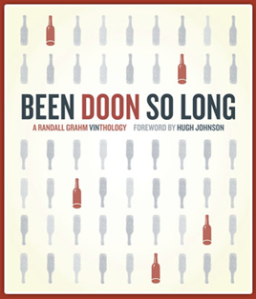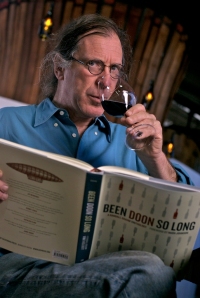
When a person takes his passionate interests very seriously, he runs the risk of becoming a geek. Ask anyone who has seen all the Star Trek movies more than once. Ask anyone who has built a computer from scratch, for fun. Ask Randall Grahm.
He takes wine as he takes his other passions - very seriously, but in a not-so-serious sort of way. That which he holds dear he treats with a razor-sharp wit. The results are smartly funny and comically smart.
Literature is obviously something very close to his soul, yet he can throw down parodies of great works like a morning-show deejay throws down parodies of Michael Jackson songs. He's the Weird Al Yankovic of the Dewey Decimal System. His love and knowledge of wine is beyond question, yet he named his flagship wine after a French flying-saucer-in-the-vineyard story. And a very serious wine it is.
Now Grahm has written a book in which he lets his geek flag fly.
Been Doon So Long starts with a pun utilizing his winery's name and continues with unabated geekness throughout.
Grahm's writing is rich and complex with layer upon layer peeling away to reveal nuances guaranteed to make the wine geek in you come out and party.
The founder of
Bonny Doon Vineyard fills each page with his extensive oenological knowledge and expansive literary and historical references. This is quite entertaining to a reader with some background knowledge about wine in general and Grahm specifically. Anyone attempting to pierce this tome without at least a cursory exposure to his wry and sometimes tangled wit is treading ground which may prove to be too hard for tilling.
Grahm has written this book for those "in the know," and it will take either a vast bank of knowledge or constant Wikipedia usage to keep up with him. Most of the humor - besides being unrelentingly oblique - is rooted nearly completely in wine lore. In his
Ten Ways You Know You’ve Met a Real Wine Geek, my favorite is number nine: "He has intimated that he would like to 'date' Jancis." If you aren't aware that Jancis Robinson is a world-renowned wine authority the joke is clearly lost, and that is probably the most accessible item on the ten-item list which contains 16 footnotes.

That said, the market for this book is most likely people who like Bonny Doon and Randall Grahm. It may not be for everyone, but Grahm certainly knows his audience.
One chapter details the evolution of the labels of the Bonny Doon family, from the rather plain-looking early ones for the Bonny Doon Pinot Noir and Chardonnay, through "Old Telegram," "Le Cigare Volant," "Clos de Gilroy and "Ca del Solo" to "Cardinal Zin" and the beautifully understated label for "Ca del Solo Albarino."
A great portion of Been Doon So Long consists of parodies of great art. Many of his literary parodies were created as promotional support for his wines. In newsletters that were eagerly awaited by his fans, he hawked his wares in the various voices of Thomas Pynchon, Franz Kafka and James Joyce. He even utilizes the hedonistic descriptive style of one Robert Parker. My favorite is
Don Quijones, the Man for Garnacha, or A Confederacy of Doonces. A companion chapter has Grahm delving into the world of verse, taking poetic license with everything from The Inferno to Howl. Having these parodies collected in one volume is no doubt the best Christmas gift many of his fans received.
Writing about some of his recurring themes Grahm cites, "the banality of Chardonnay, the pretentiousness of Napa Valley, the banal pretentiousness of Napa Valley Chardonnay...lead to a heartfelt cry for tolerance of diverse wine styles and the oddball grape varieties." As a wine drinker who is relentlessly drawn to to wines made from grapes little known to me, I relate well to his footnoted feelings of ABC, "Anything But Cabernet (or Chardonnay.)" Nowadays, there are plenty of California winemakers dabbling in the Rhone varieties; any one of them might be referred to as a Rhone Ranger. Grahm, in the mid 1980s, was, more or less,
THE Rhone Ranger. Just as the California wine pioneers before him did, Grahm's Bonny Doon helped pave the way for other dreamers who kicked clods of dirt in between their rows of Roussanne.
From a literary standpoint, Grahm seems pathologically obsessed with notation, footnotes appearing in his writing almost as frequently as adjectives. This allows him to cram in triple the information that the normal structure of a sentence would allow. I don't remember seeing it, but I'm sure somewhere within the pages there is a footnote within a footnote. His full commitment to the obscure reference at least partially explains his dependence upon footnotes.
If that sounds a tad negative, please note - or footnote, if you will - that I really enjoy interesting reading, even when there is a dangerously long tangential offshoot waiting around every preposition. Grahm's writing is indeed interesting. I also admire a good obscure reference from time to time, as long as it is fully explained in the footnotes.
Anyone who has ever enjoyed a Bonny Doon wine could find something to like about
Been Doon So Long. Grahm relates wine to the worlds of song, story, stage and screen in a most entertaining fashion. In a way, this book exhibits Grahm's roots and influences in the same way wine exhibits the roots and influences of the grapes. It's his
terroir on display here. If you are in on the jokes, the book will have you convulsing in laughter. If you are on the outside of his references looking in, better pay close attention to those footnotes.


